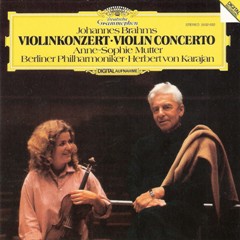111 Years of Deutsche Grammophon - CD 37
111 Years of Deutsche Grammophon - CD 37
Brahms: Violin Concerto, Op.77; Double Concerto, Op.102

Violin Concerto in D, Op.77 1 1. Allegro non troppo [22:02] 2 2. Adagio [9:42] 3 3. Allegro giocoso, ma non troppo vivace - Poco più presto [8:35] Concerto for Violin and Cello in A minor, Op.102 4 1. Allegro [18:04] 5 2. Andante [7:30] 6 3. Vivace non troppo - Poco meno allegro - Tempo I [9:11] Anne-Sophie Mutter – violin António Meneses- cello Berliner Philharmoniker Herbert von Karajan – conductor
Violin Concerto in D major, Op. 77 is a violin concerto in three movements composed by Johannes Brahms in 1878 and dedicated to his friend, the violinist Joseph Joachim. It is Brahms's only violin concerto, and, according to Joachim, one of the four great German violin concerti. Originally, the work was planned in four movements like the second piano concerto. The middle movements, one of which was intended to be a scherzo — a mark that Brahms intended a symphonic concerto rather than a virtuoso showpiece — were discarded and replaced with what Brahms called a "feeble Adagio." Some of the discarded material was reworked for the second piano concerto.
Brahms, who was impatient with the minutiae of slurs marking the bowing, rather than phrasing, as his usual practice was[clarification needed], asked Joachim's advice on the writing of the solo violin part. Joachim, who had first been alerted when Brahms informed him in August that "a few violin passages" would be coming in the mail, was eager that the concerto should be playable and idiomatic, and collaborated willingly, not that all his advice was heeded in the final score. The most familiar cadenza, which appears in the first movement, is by Joachim, though a number of people have provided alternatives, including Leopold Auer, Henri Marteau, Max Reger, Fritz Kreisler, Jascha Heifetz, George Enescu, Nigel Kennedy and Rachel Barton Pine. A recording of the concerto released by Ruggiero Ricci has been coupled with Ricci's recordings of sixteen different cadenzas.
The Double Concerto in A minor, Op. 102, by Johannes Brahms is a concerto for violin, cello and orchestra. The Double Concerto was Brahms' final work for orchestra. It was composed in the summer of 1887, and first performed on 18 October of that year in the Gürzenich in Köln, Germany. Brahms approached the project with anxiety over writing for instruments that were not his own. He wrote it for the cellist Robert Hausmann, a frequent chamber music collaborator, and his old but estranged friend, the violinist Joseph Joachim. The concerto was, in part, a gesture of reconciliation towards Joachim, after their long friendship had ruptured following Joachim's divorce from his wife Amalie. (Brahms had sided with Amalie in the dispute.)
The concerto also makes use of the musical motif A-E-F, a permutation of F-A-E, which stood for a personal motto of Joachim, Frei aber einsam ("free but lonely"). Thirty-four years earlier, Brahms had been involved in a collaborative work using the F-A-E motif in tribute to Joachim: the F-A-E Sonata of 1853.
